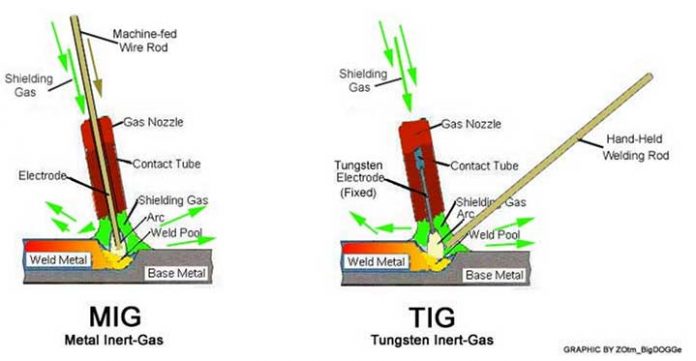Across the U.S., two of the most common welding technologies are:
- Metal inert gas (MIG) welding
- Tungsten inert gas (TIG) welding
Both of these arc welding techniques are similar, but in some cases, one turns out to be more useful than the other. So, which one is better? And what is the difference between the two? Both of these processes use electric arcs for producing heat and joining metallic objects. Also, both MIG and TIG use the inert gas mixture to keep from the corrosion of welding electrodes.
But they differ from each other in few areas. So, let’s take a look:
MIG and TIG Welding – How do they work
MIG welding is a process that entails continuous feeding a metal wire into the weld being made. The consumable welding supply of the wire serves as a filler material to assist with joining two metal objects. It is also called as GMAW – Gas Metal Arc Welding.
Tungsten inert gas welding is done with a consumable tungsten electrode running a current through the metals that are being joined together. It may or may not use a filler metal for the welding supply. Its other name is GTAW – Gas Tungsten Arc Welding.
Comparison of Material Thickness between MIG & TIG
As MIG welding uses a consumable filler material for making welds, it can weld the thicker metal objects quicker than a TIG weld. Without it, TIG welding shall require these pieces of metal being welded hot enough to form a bond, and it is easier with thinner pieces. Using thicker pieces can create heat stress, among other issues. MIG is ideal for heavy-duty welds, and TIG welding is ideal for thinner pieces of metal.
Ease of Use
As far as ease of use is concerned, MIG welding is recommended. It is ideal for beginners and non-professionals. On the other hand, TIG needs strict control over the electric current, pressure, and timing. TIG welding is best carried out with an automated and numerically-controlled (CNC) welding machine.
Which one is the ideal?
Which one is the better option for you, depends on the kind of job. As stated earlier, MIG welding is a better option for heavy-duty welding for larger and thicker pieces of metal using filler material. TIG welding is best for mending smaller and thinner pieces of metal together without using filler material, so you save money on welding supplies.
So, it all depends on your requirements.
How to decide on to choose one?
How do you decide which of the methods is best? There are a few considerations you have to keep in mind that can help you in choosing the best method:
- See how thick are the pieces you want to join? It is not easy to weld thicker pieces of sheet metal by only heating them until they fuse. They need more energy due to their thickness to reach their melting point. TIG welding becomes less efficient. MIG is effective in such cases.
- Are you welding dissimilar metals? Welding dissimilar metal leads to various issues, such as weld corrosion and weak bonds. But it is unavoidable in some cases. When you weld two dissimilar metals, you should use a welding technique that uses a filler material for creating a bond. Be careful in choosing this filler material.
- Consider the surface smoothness before welding. There are more chances of getting surface flaws from filler materials as they increase the weld spatter on the surface of a workpiece. It is important to smoothen the surface. Direct metal-to-metal welds prevent this issue and lead to creating cleaner welds compared to filler-dependent ones.
- The electrical conductivity of the metal should be taken into account. You should consider the electrical conductivity of the metals that are being joined. Welding uses heat to join metal in an electric arc, which is generated by the inherent electrical resistance of the metal as the arc tries to pass through the weld site.
If the metal is highly ductile, it will need more time to heat up, consuming more energy. Metals that are electrically-resistant heat up faster that makes it easier to weld them without using filler material.
Note: No matter what kind of welding you decide to go for, make sure that you have all the necessary gear for it such as gloves, welding helmet, and safe apparel. Welding Corner is one such place where you can buy all this stuff.

